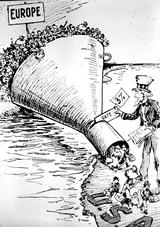Immigration History
Quota System 1921-1965
 Quota Act
Quota Act
|
1921 "The terms of the 1921 quota system prohibited no more than 3 percent of the number of foreign-born residents of that nationality living in the U.S. in 1910. The law applied to the nations of Europe, the Middle East, Africa, Australia, New Zealand, Asian Russia, and certain islands in the Atlantic and Pacific." (1)
1924 "The quota system was changed in 1924 and was based on the desirability of various nationalities. For example, immigrants from northern and western Europe were consider much more desirable than those of southern and eastern Europe and more adapt to 'fit in.' Consequently, countries like Great Britain, Germany, and Ireland were given generous quotas, while nations like Russia, the source of most Jewish immigrants, and Italy were cut back. Almost all Asian were excluded from the U.S." (2)
1924 - Congress created the U.S. Border Patrol within the Immigration Service.
1929 - For the first time, it became illegal to cross the border from Mexico into the U.S. without federal documents.
1933 - Executive Order 6166 of June 10, 1933, combined the Immigration Service and the Naturalization Bureau into one agency, the Immigration and Naturalization Service.
1941 "Congress passes an act that refuses visas to foreigners whose presence in the U.S. might endanger public safety." (1)
1945 "INS programs of the late 1940s and 1950s addressed conditions in post-war Europe. The War Brides Act of 1945 facilitated admission of the spouses and families of returning American soldiers. The Displaced Persons Act of 1948 and Refugee Relief Act of 1953
 Tijuana border ca. 1950
Tijuana border ca. 1950
|
 Tijuana border ca. 1950
Tijuana border ca. 1950
|
allowed for admission of many refugees displaced by the war and unable to come to the United States under regular immigration procedures. With the onset of the Cold War, the Hungarian Refugee Act of 1956, Refugee-Escapee Act of 1957, and Cuban Adjustment Program of the 1960s served the same purpose." (2)
1946 "A federal law of 1946 authorizes the admission of persons of races indigenous to India to the U.S. under an annual quota" (1)
1952 "The Immigration and Nationality Act of 1952 incorporates most of the existing laws relating to immigration including two major changes: the Asiatic Barred Zone which banned most Asian immigrants since 1917 was abolished and people from all nations are given the opportunity to enter the U.S." (1)
1953 "The Refugee Act of 1953 makes an additional allocation of places for the victims of the war disaster" (1)
Fifth Wave 1965-2000
Sources:
- Immigration Through Time
- INS History
- Center for Immigration Studies
- Border Revolution by Cindy Baxman

